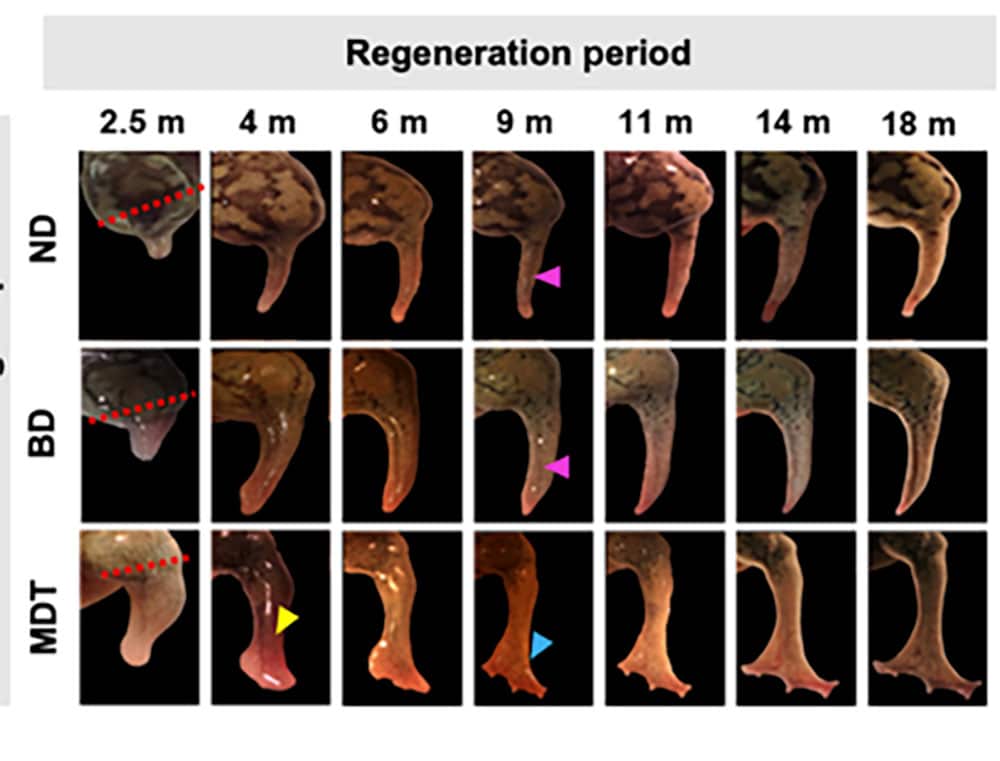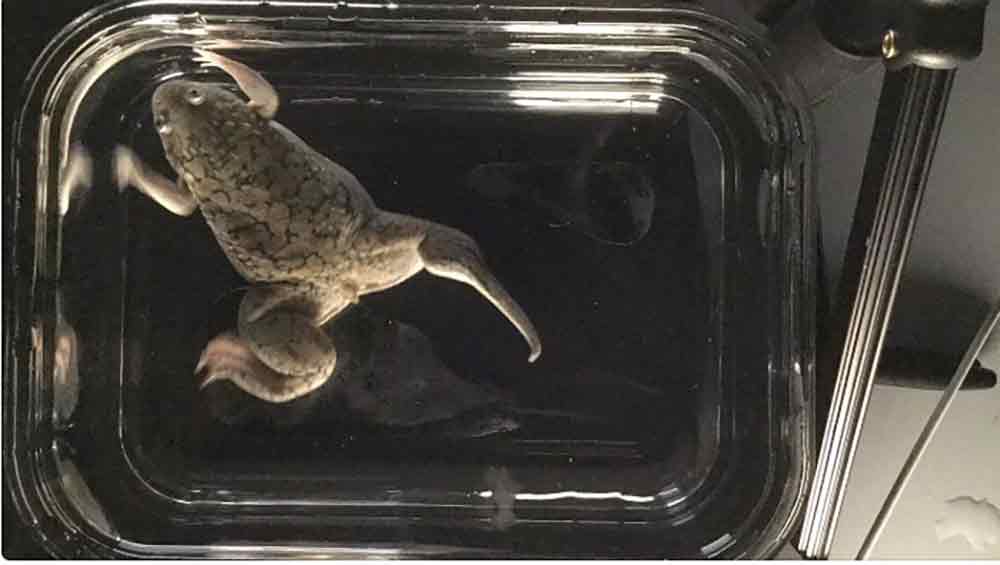The researchers surgically removed one hind leg of adult African clawed frogs and then used a silicone sleeve, called a BioDome cap, on the stump to administer a five-drug cocktail that they hoped would stimulate regeneration.
The African clawed frog (Xenopus laevis) has the capability to regenerate its hind limbs with the aid of a five-drug cocktail applied to the severed area of the frog’s legs and kept there for 24 hours, according to researchers with the Tufts and Harvard University’s Wyss Institute.
The researchers surgically removed one hind leg of adult African clawed frogs and then used a silicone sleeve, called a BioDome cap, on the stump to administer a five-drug cocktail that they hoped would stimulate regeneration.

FIG. 1. Twenty-four–hour multidrug treatment delivered by bioreactor improves repatterning in regenerates.(A) Xenopus hindlimbs were amputated and inserted into silk-based hydrogel devices (yellow arrow) for 24 hours. Hydrogels contained a multidrug treatment (MDT) or no added factors (BD). Some animals received no device (ND). (B) Regenerated MDT hindlimbs were longer than the BD and ND groups by 2.5 mpa, as indicated by growth beyond resection site (red dashed line). At 4 mpa, vascularized structures developed at the distal extension of MDT, but not BD or ND regenerates. At 9 mpa, digit-like projections appeared (blue arrow), contrasting the hypomorphic spikes of BD and ND regenerates (pink arrows). (C) Soft tissues of MDT animals were consistently longer than BD or ND from 8 mpa [F(2,19) = 61.9, P < 0.05]. (D) Micro-CT reconstructions revealed increases in regenerate bone length (yellow arrow) and volume, as well as diffuse bone (purple arrow). (E) Volumetric quantification confirmed increased growth in MDT regenerates [F(2,15) = 11.15, P < 0.001]. (F) Tuberculae complexity increased in MDT-exposed tissue. (G) Micro-CT reconstructions show reestablishment of fine bone structures in MDT regenerates (purple arrow). (H) Longitudinal x-ray imaging indicates gradual accelerated bone growth in MDT [F(2,19) = 31.04, P < 0.05]. Means and SD are presented. *P < 0.05; **P < 0.01; ***P < 0.001.
African Clawed Frog Embryos Can Fully Regenerate Their Eyes After Injury
“Mammals and other regenerating animals will usually have their injuries exposed to air or making contact with the ground, and they can take days to weeks to close up with scar tissue,” said David Kaplan, one of the researchers at the Department of Biomedical Engineering, Tufts University, Medford, MA. “Using the BioDome cap in the first 24 hours helps mimic an amniotic-like environment which, along with the right drugs, allows the rebuilding process to proceed without the interference of scar tissue.”
The BioDome was attached for just 24 hours, but after 18 months the frog limbs grew dramatically, re-creating a nearly fully functional leg. These legs included bone structures smart to a natural frog leg’s bone structure, more robust internal tissues including neurons and toes that grew from the end of the limbs. The newly grown limbs were even used by the frogs to swim through the water.
“It’s exciting to see that the drugs we selected were helping to create an almost complete limb,” Nirosha Murugan, research affiliate at the Allen Discovery Center at Tufts said in a statement released by the university. Murugan is the first author of the paper. “The fact that it required only a brief exposure to the drugs to set in motion a months-long regeneration process suggests that frogs and perhaps other animals may have dormant regenerative capabilities that can be triggered into action.”
The complete study, “Acute multidrug delivery via a wearable bioreactor facilitates long-term limb regeneration and functional recovery in adult Xenopus laevis” can be read on the Science Advances website.
About African Clawed Frogs
The African clawed frog is an invasive species in the United States and is known for its voracious appetite, eating virtually any animal that it can fit into its mouth. It is highly resistant to disease, and spends the majority of its life, if not all of its life in the water. It has a smooth skin that is slimy to the touch and claws on its hind legs. It grows to about five inches in length and is native to Africa. Xenopus laevis is currently regulated in Arizona, California, Kentucky, Louisiana, New Jersey, North Carolina, Oregon, Virginia, Hawaii, Nevada, and Washington.


